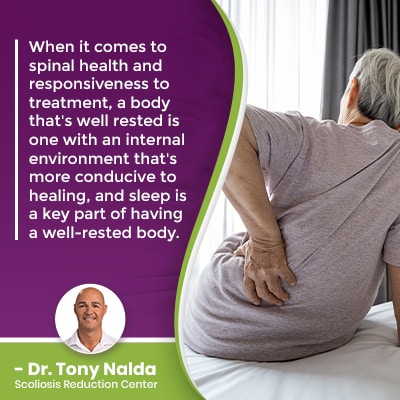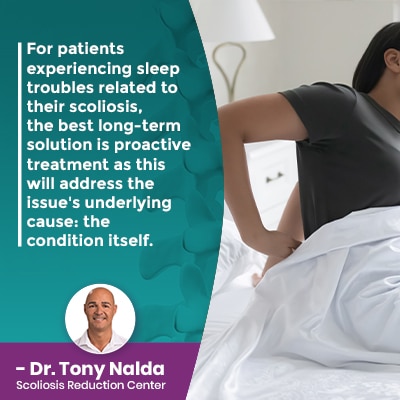What Are The Best Sleeping Positions For Scoliosis?

Sleep is important for everyone, but for those living with scoliosis, it can help make the body more responsive to treatment. In addition, people with scoliosis can experience disruptions to sleep due to pain and/or other condition-related effects, so working towards developing some scoliosis-friendly sleep habits can help.
The best sleeping positions for scoliosis are the same as for everyone: flat on the back, followed by sleeping on the side, and flat on the stomach is the worst sleep position for spinal health.
Before exploring the best specific sleep positions for scoliosis, let's first talk about what's happening inside the body of someone recently diagnosed, and why getting a good night's sleep can be a challenge.
Table of Contents
What is Scoliosis?
Scoliosis is a progressive structural spinal condition that involves the development of an unnatural sideways spinal curve, with rotation, and a minimum Cobb angle measurement of 10 degrees.
A patient's Cobb angle is determined during X-ray and tells me how far out of alignment a scoliotic spine is.
When the spine's healthy and natural curves are in place, its vertebrae (bones of the spine) are aligned as they should be, but if an unhealthy curve develops, the vertebrae at the apex of that curve are excessively tilted, causing a misaligned spine, and a lot of uneven forces.
The condition's uneven forces equal uneven pressure on the spine and its surrounding muscles and nerves, which is why a muscle imbalance can be caused by scoliosis.
It's not just the spine that has to maintain its natural curves and alignment, but also its surrounding muscles, so it makes sense that those muscles would also be affected by the condition's uneven forces.
Muscles on one side of the spine can become stretched and loose from overuse, while the muscles on the other side of the spine can be weak from underuse.
The main symptom of scoliosis in adolescent idiopathic scoliosis (AIS), the condition's most prevalent type, is postural deviation, and the main symptom of scoliosis in adults is pain.
Changes to posture and/or experiencing condition-related pain can cause sleeping difficulties.
Best Sleeping Positions for Scoliosis
 When it comes to spinal health and responsiveness to treatment, a body that's well rested is one with an internal environment that's more conducive to healing, and sleep is a key part of having a well-rested body.
When it comes to spinal health and responsiveness to treatment, a body that's well rested is one with an internal environment that's more conducive to healing, and sleep is a key part of having a well-rested body.
While not everyone with scoliosis will experience condition-related sleep problems, it can become an issue, especially if scoliosis progresses, becoming more severe.
As a progressive condition, scoliosis has it in its nature to get worse over time, especially if left untreated, and scoliosis can range from mild to moderate and severe to very severe.
The more severe the condition, the more noticeable its effects are likely to be, including any related troubles with sleep.
Sleeping Flat on the Back
Sleeping flat on the back is the best position for people with scoliosis, and everyone, and this is because it keeps the spine in a straight and neutral position.
The body's weight is evenly distributed along the spine: no one section taking on more weight than the others.
The spine is not being put in an unnatural position, and this can also help with pain relief as pressure is taken off the spine.
Sleeping with scoliosis means finding the position that best suits the individual in terms of comfort, but when it comes to the best sleeping position for spinal alignment and spinal health, that's back sleepers.
Side Sleeping
After sleeping flat on the back, side sleeping is the next best sleeping position, and this is especially true if a thin pillow is placed between the knees so the spine is better aligned and in a more neutral position.
Knowing where to place pillows can help people with scoliosis get a better sleep, and a cervical pillow can help with ensuring the neck has enough stability to properly support the weight of the head and that there is no unnatural neck twist occurring.
Supportive pillows can help take pressure off the spine during sleep, which can help with pain relief and the ability to find a good sleeping position.
Stomach Sleeping
The stomach sleeping position is preferred by many, but is the worst position for spinal health.
Lying flat on the stomach involves arching the upper back unnaturally, and the neck also has to be bent to the side at an unnatural angle, so this is exposing the spine and body to more uneven forces: something scoliosis is already causing.
Stomach sleeping puts the body weight on the spine, adding pressure, and this is why people in general, and people with scoliosis in particular, should avoid sleeping on the stomach.
Proactive Scoliosis Treatment and Sleep
 For patients experiencing sleep troubles related to their scoliosis, the best long-term solution is proactive treatment as this will address the issue's underlying cause: the condition itself.
For patients experiencing sleep troubles related to their scoliosis, the best long-term solution is proactive treatment as this will address the issue's underlying cause: the condition itself.
If a scoliotic curve is causing pain and or postural deviation that makes it difficult to find a comfortable sleeping position, it's time to seek out guidance, support, and professional medical advice.
Here at the Scoliosis Reduction Center, I treat patients with a conservative chiropractic-centered treatment approach that is proactive because treatment is started as close to the time of diagnosis as possible.
While there are never treatment guarantees, treatment started early in a condition's progressive line means the spine is going to be more flexible and responsive, and related issues like a muscle imbalance are unlikely to be as severe, and treatment success is at its most likely.
Scoliosis progressing means the unnatural spinal curve is getting larger, and the condition's uneven forces are also increasing, as are their effects.
The more progression a person experiences, the more severe their condition, and severe cases are the most likely to disrupt a person's ability to fall asleep, and stay asleep.
Chiropractic Care
Proactive treatment works towards preventing progression through impacting the condition, first and foremost, on a structural level; this involves a series of chiropractic techniques and manual adjustments that can realign the spine.
Physical Therapy
Physical therapy and the use of scoliosis-specific exercises (SSEs) and stretches can also help with muscle strengthening so the spine can be optimally supported and stabilized by its surrounding muscles.
In addition, these types of exercises can help address any related muscle imbalance and can activate specific areas of the brain for improved brain-body communication, posture, and a more balanced and natural body position.
Corrective Bracing and Rehabilitation
Corrective bracing can be another facet of treatment that can help improve an abnormal spine curve by pushing the spine into a corrective position, and a series of custom-prescribed exercises and stretches can help patients establish a home-rehabilitation program to further stabilize the spine for long-term results.
For people experiencing sleep difficulties with scoliosis, the underlying cause of those difficulties is the scoliosis itself, so addressing the condition proactively can help minimize the condition's effects, sleep troubles included.
Conclusion
In addition to knowing the best sleeping position for people with scoliosis, having a comfortable and supportive mattress can also help.
The use of supportive pillows can also be recommended by a treatment provider as a means of ensuring the body's weight is evenly distributed along the spine during sleep and that the spine is optimally supported and held in a neutral position.
The best sleeping position for spinal alignment and health is lying flat on the back, and this is because the spine is held in a straight, neutral, and even position, while a person's body weight is evenly distributed along the entire spine.
Having an unnatural scoliosis curve can affect sleep in different ways; it can make it more difficult to find a comfortable sleeping position, back pain can disrupt a person's ability to fall asleep, and stay asleep, and severe cases can cause lung impairment making it difficult to settle into a rhythmic breathing pattern during sleep.
After back sleeping, the next best sleeping position is side sleeping, followed by sleeping flat on the stomach as the worst sleeping position for people with, and without, scoliosis.
If a person's scoliosis is bothering them to the point of disrupting sleep, the body is not going to be as capable of healing and restoring itself, nor it will it be as responsive to treatment.
The best way to minimize the effects of scoliosis is to treat it proactively so progression can be prevented, and a curvature reduction reduces the condition's uneven forces, while addressing it on a structural level.
Dr. Tony Nalda
DOCTOR OF CHIROPRACTIC
After receiving an undergraduate degree in psychology and his Doctorate of Chiropractic from Life University, Dr. Nalda settled in Celebration, Florida and proceeded to build one of Central Florida’s most successful chiropractic clinics.
His experience with patients suffering from scoliosis, and the confusion and frustration they faced, led him to seek a specialty in scoliosis care. In 2006 he completed his Intensive Care Certification from CLEAR Institute, a leading scoliosis educational and certification center.
About Dr. Tony Nalda
 Ready to explore scoliosis treatment? Contact Us Now
Ready to explore scoliosis treatment? Contact Us Now





